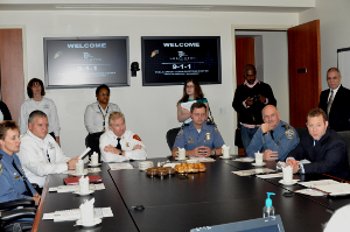From Des Moines to Charlottesville school districts across the country are making sure there is a laptop in the hands of every high school student. California’s e-textbook initiative augurs the nationwide rise of digital course materials. Teachers now use web videos to reinforce the quadratic formula or impart a civics lesson. Technology is moving forward. Our classrooms and our curriculum need to catch up.
We’re joining with the New York City Department of Education tomorrow morning for an event on digital learning in the 21st century. We’ll speak on the promise of wireless and present a roundtable on the future of K – 12 education, as America begins to employ digital learning solutions. This includes the adoption of digital textbooks and the possibilities of wireless technology to enhance learning in the classroom. Wednesday’s event will explore both the benefits and the obstacles to this shift. The event will take place tomorrow, March 9 from 10:30am to 12:15pm at the NYC iSchool at 131 6th Avenue, at Dominick Street.
Sharing the stage with Chairman Genachowski at the roundtable is a handful of the nation’s standouts in education, from both the public and private sectors. This includes Sharon Greenberger, COO of the NYC Department of Education; Alisa Berger, Principal of NYC iSchool, our host; Matthew Small, Chief Business Officer at Blackbord; and other luminaries.
There’s no better school to debut this initiative and hold this roundtable than the NYC iSchool. The iSchool, which introduced its first class in September 2008, looks to set the bar for 21st century learning. The innovative high school incorporates cutting edge technology into students’ everyday learning and both its teachers and students make it a central part of their mission to harness these tools. To learn more about the NYC iSchool, check out this video.
Join us. If you’re in the New York City area tomorrow, the event is free and open to the public – though we’d appreciate your pre-registration. Send an email with your name, organization name (if applicable) and phone number to diglearning [at] fcc [dot] gov.










 Like each of you, I understand that the health of America as a nation is inextricably dependent on the health of rural America. My hometown was an agricultural, railroad town in the rural plains of Arkansas, where farmers made their living raising cotton, rice, and soybeans. Just as my hometown farmers realized in the 1920s and 1930s that electricity was essential for them to compete, Americans today realize that broadband is no longer a luxury but a necessity to participate in the modern economy.
Like each of you, I understand that the health of America as a nation is inextricably dependent on the health of rural America. My hometown was an agricultural, railroad town in the rural plains of Arkansas, where farmers made their living raising cotton, rice, and soybeans. Just as my hometown farmers realized in the 1920s and 1930s that electricity was essential for them to compete, Americans today realize that broadband is no longer a luxury but a necessity to participate in the modern economy. Over a century ago, Alexander Graham Bell met with the President of the United States, Rutherford B. Hayes, to demonstrate a new invention: the telephone. After Bell finished his demonstration, the President turned to him and said, “That’s an amazing invention, but who would ever want to use one of them?”
Over a century ago, Alexander Graham Bell met with the President of the United States, Rutherford B. Hayes, to demonstrate a new invention: the telephone. After Bell finished his demonstration, the President turned to him and said, “That’s an amazing invention, but who would ever want to use one of them?” Tomorrow at 12:00PM (9:00AM PT), FCC Chairman Julius Genachowski will appear at a public forum in Silicon Valley to discuss E-rate modernization and innovation in education. The Chairman will also announce the launch of the FCC’s Parents’ Place page. The public forum is hosted by Common Sense Media, and is about creating digital opportunity for families through innovation in education and by empowering both parents and kids online.
Tomorrow at 12:00PM (9:00AM PT), FCC Chairman Julius Genachowski will appear at a public forum in Silicon Valley to discuss E-rate modernization and innovation in education. The Chairman will also announce the launch of the FCC’s Parents’ Place page. The public forum is hosted by Common Sense Media, and is about creating digital opportunity for families through innovation in education and by empowering both parents and kids online. This morning I attended a forum on empowering small businesses with broadband hosted by John Donahoe, eBay CEO, and featuring
This morning I attended a forum on empowering small businesses with broadband hosted by John Donahoe, eBay CEO, and featuring  President Obama’s “
President Obama’s “
